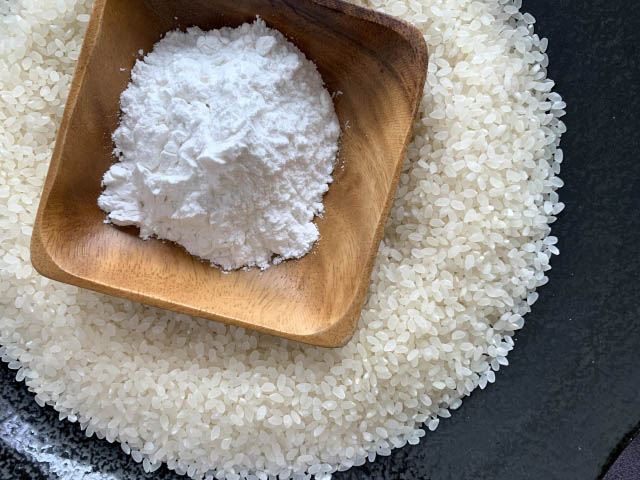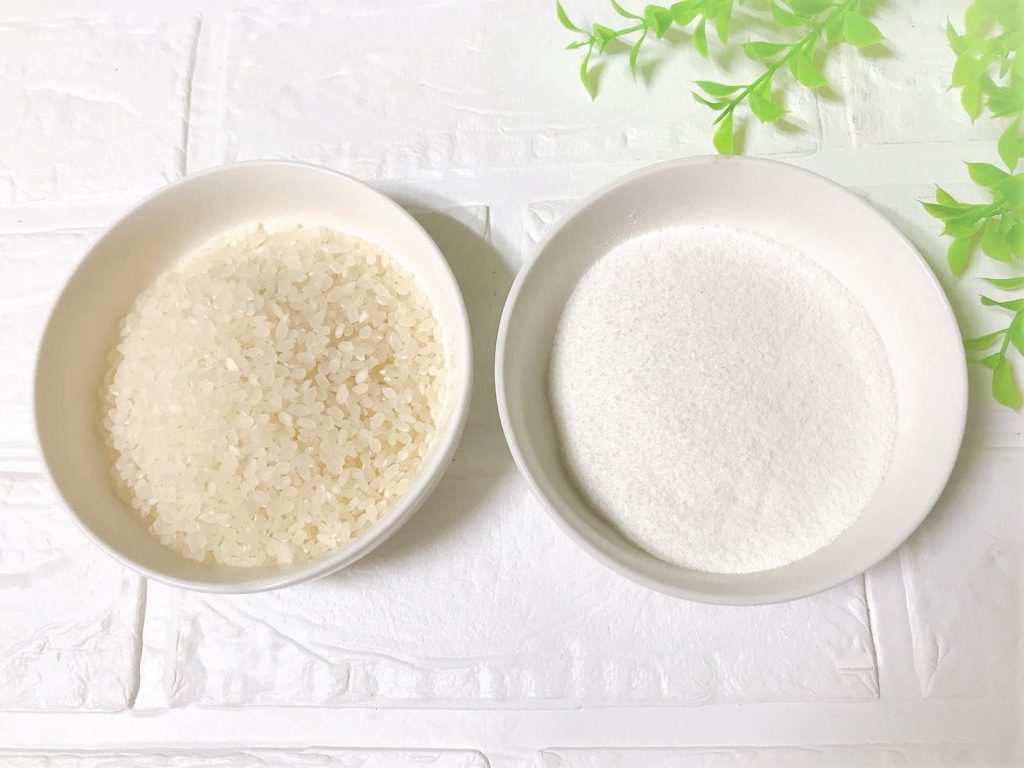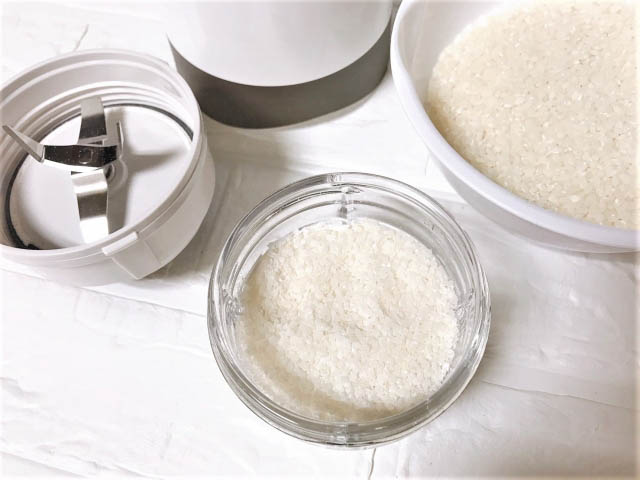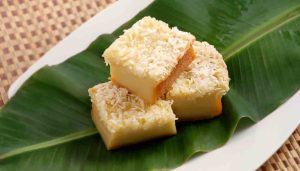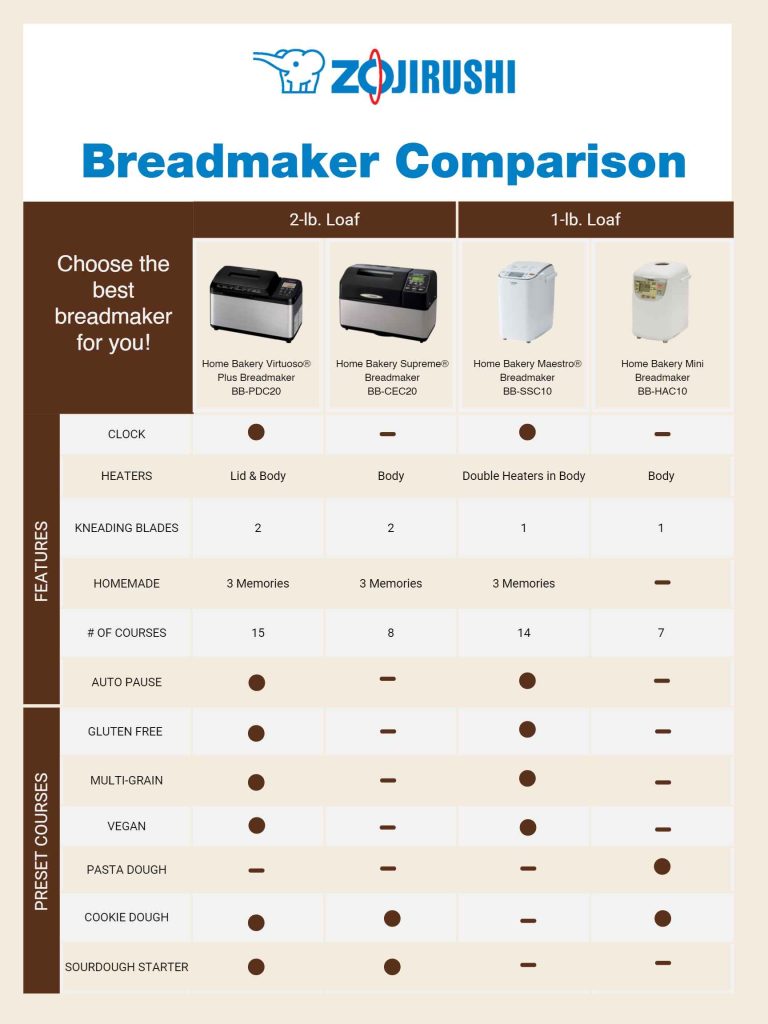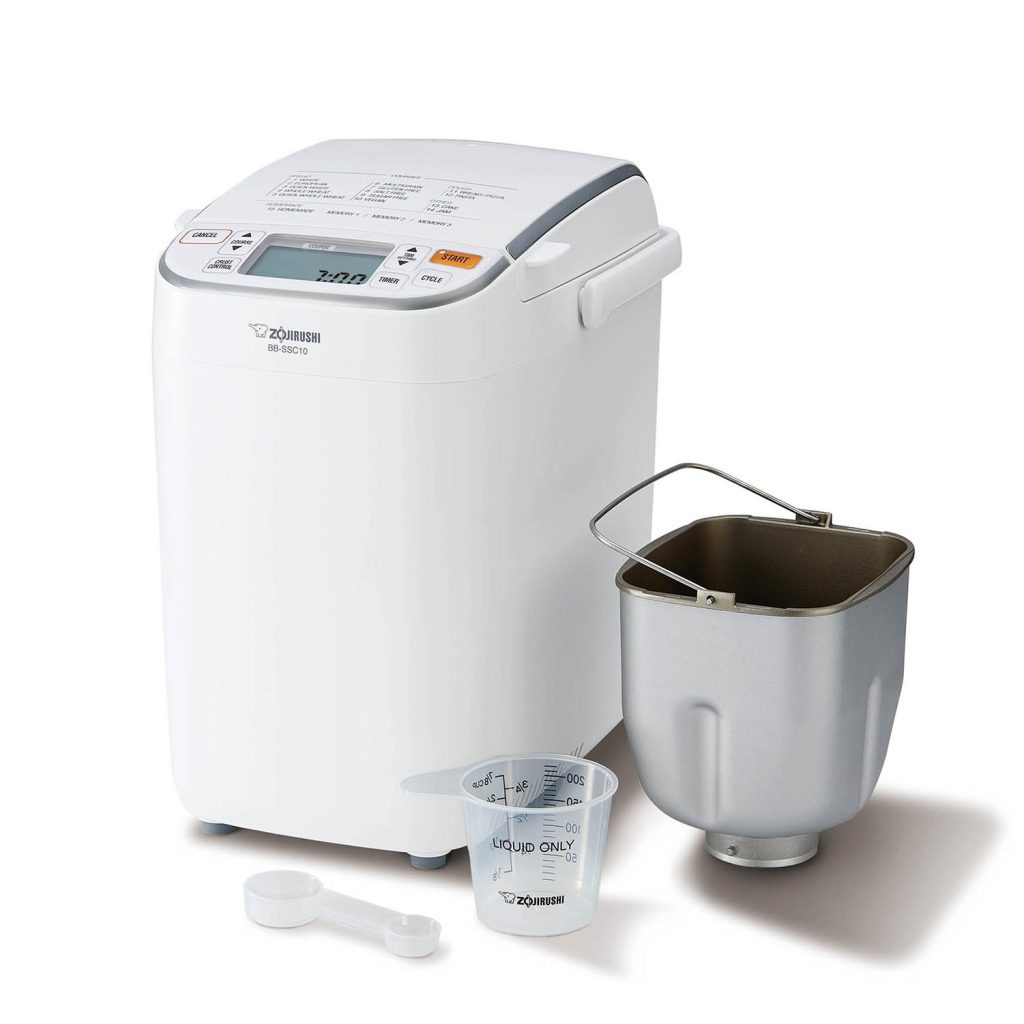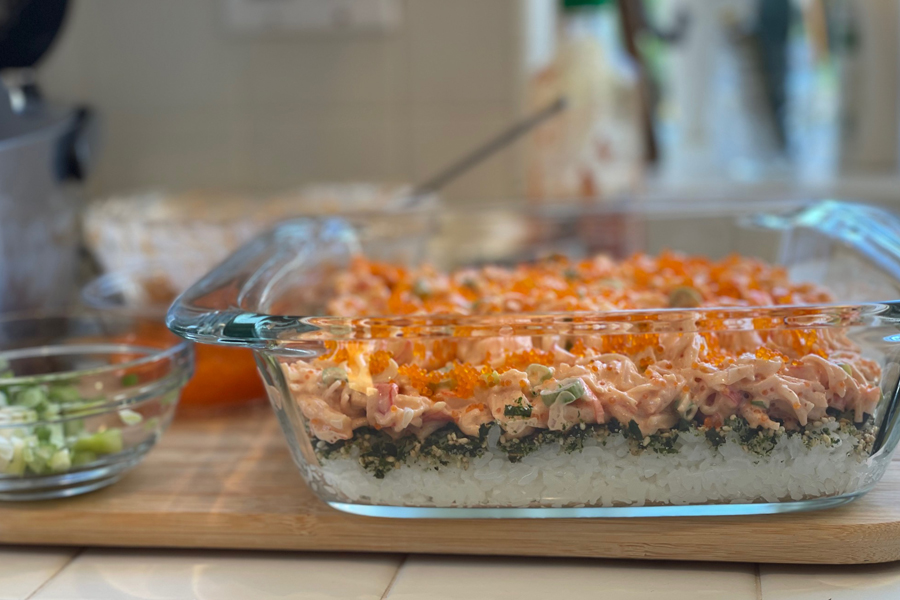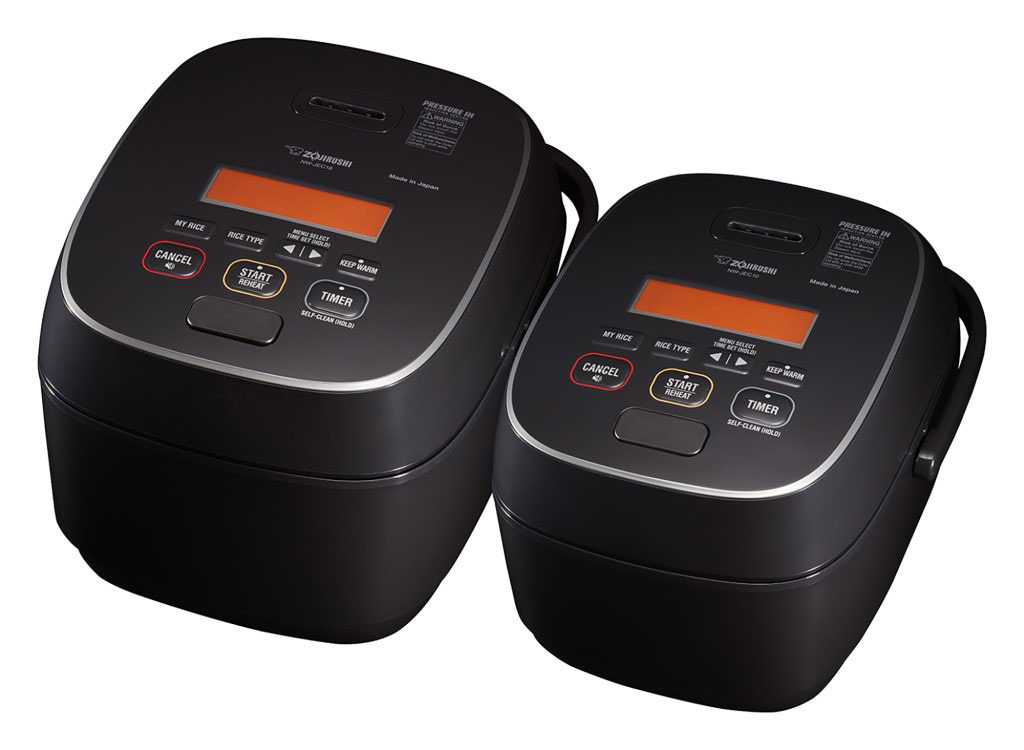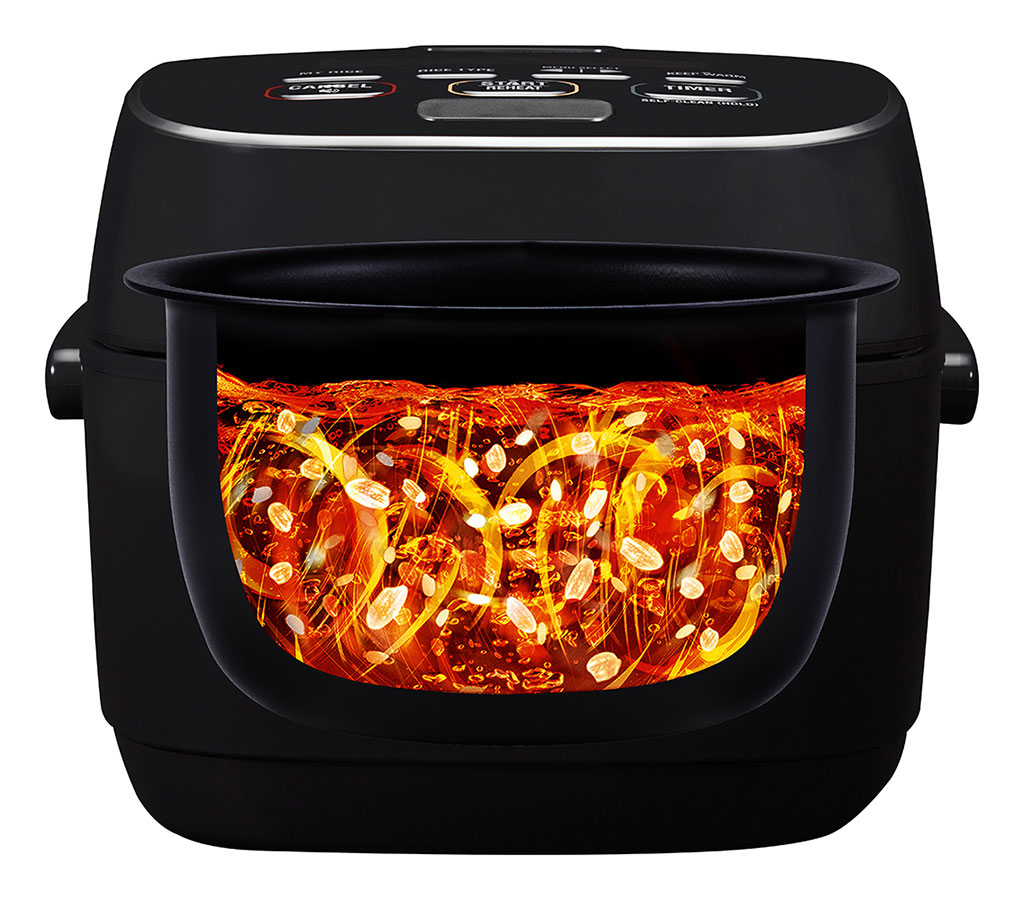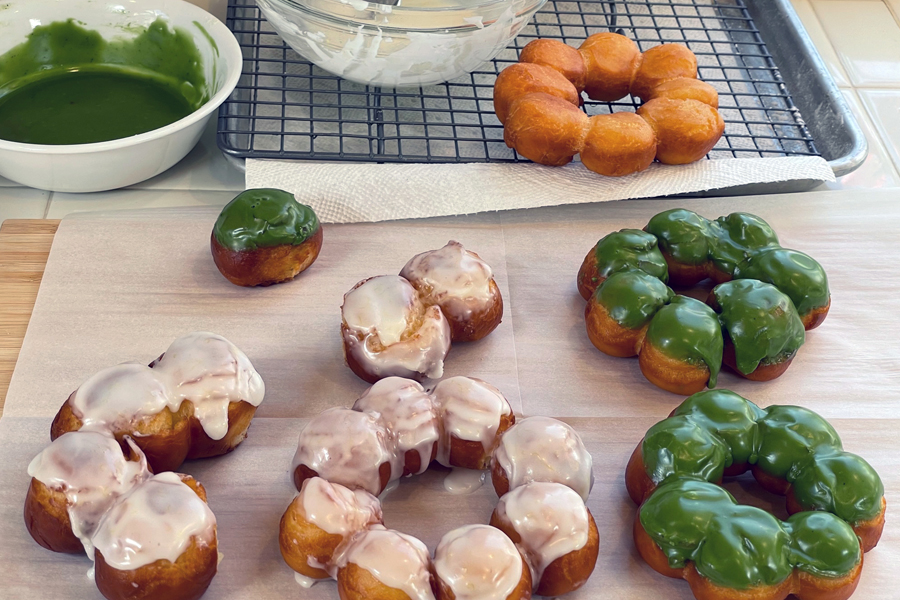 Since I’ve already confessed to having a weakness for donuts, I won’t feel guilty about celebrating National Donut Day. Nor will I feel guilty about deep frying, since baked donuts just sound lame to me. My excuse is that I’ve never deep fried before so this will be a new experience for me—and in the interest of expanding myself… I started by making the dough in my Zojirushi Breadmaker and used a bread machine recipe I found online. That was the easy part—the tricky task was to find a good, decently sized round cookie cutter. You can find all kinds of fancy ones, but try to find basic shapes and it’s not like they’re sold everywhere without having to go online. I know they probably have specialized donut cutters, but I found something that worked. I used this round one and pressed out the hole with a condiment cup I had lying around (I was a dedicated to bringing my lunch from home when I used to commute to work).
Since I’ve already confessed to having a weakness for donuts, I won’t feel guilty about celebrating National Donut Day. Nor will I feel guilty about deep frying, since baked donuts just sound lame to me. My excuse is that I’ve never deep fried before so this will be a new experience for me—and in the interest of expanding myself… I started by making the dough in my Zojirushi Breadmaker and used a bread machine recipe I found online. That was the easy part—the tricky task was to find a good, decently sized round cookie cutter. You can find all kinds of fancy ones, but try to find basic shapes and it’s not like they’re sold everywhere without having to go online. I know they probably have specialized donut cutters, but I found something that worked. I used this round one and pressed out the hole with a condiment cup I had lying around (I was a dedicated to bringing my lunch from home when I used to commute to work). 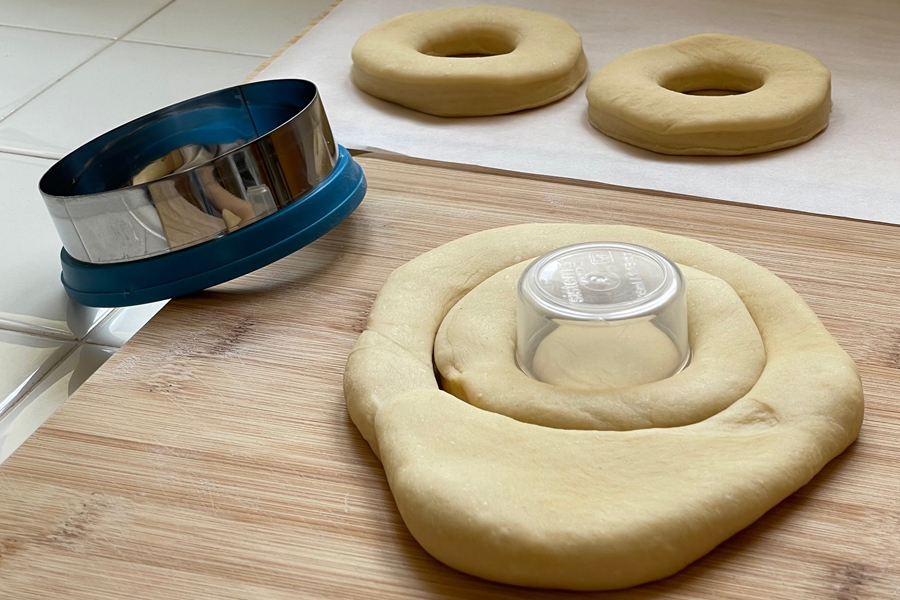 Whoa, this was a little scary for me—I don’t have a tolerance for hot oil. But they look good!
Whoa, this was a little scary for me—I don’t have a tolerance for hot oil. But they look good! 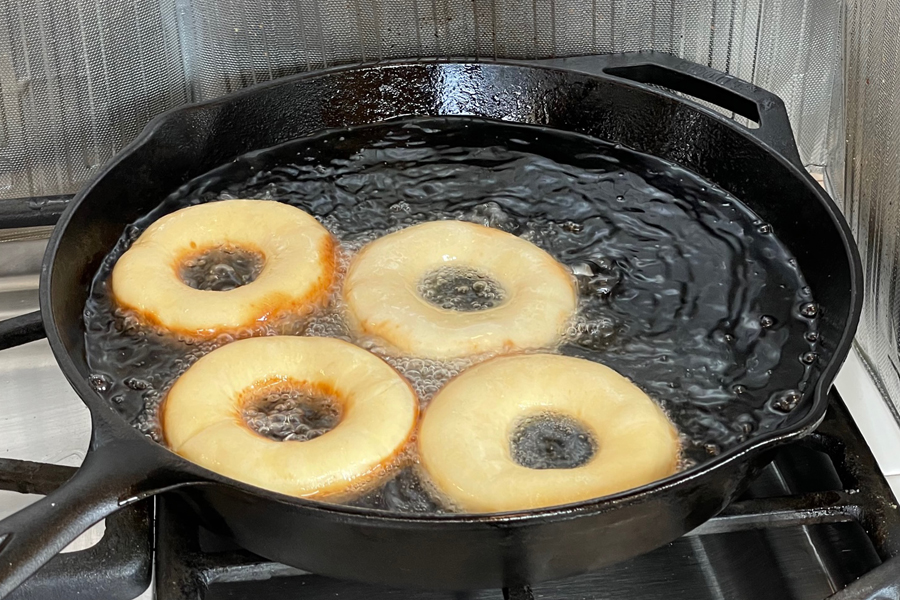 The other scary thing is that you have to work fast because they fry up so quick. As a novice fryer, I was trying to be too delicate with the tongs because I was afraid of ruining the donut. But I got used to just grabbing them with no major accidents.
The other scary thing is that you have to work fast because they fry up so quick. As a novice fryer, I was trying to be too delicate with the tongs because I was afraid of ruining the donut. But I got used to just grabbing them with no major accidents. 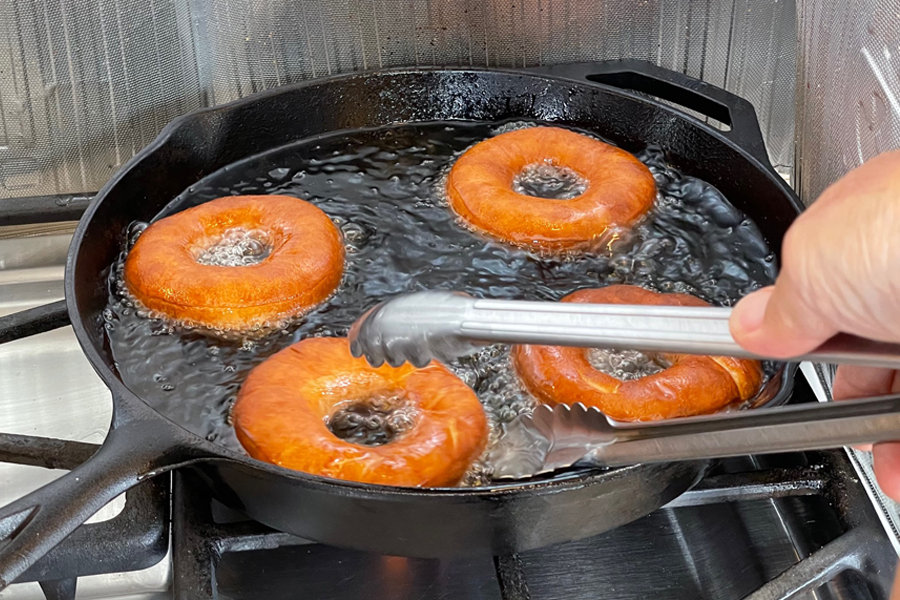 All that was left was to dip them in cinnamon sugar for the finishing touch.
All that was left was to dip them in cinnamon sugar for the finishing touch. 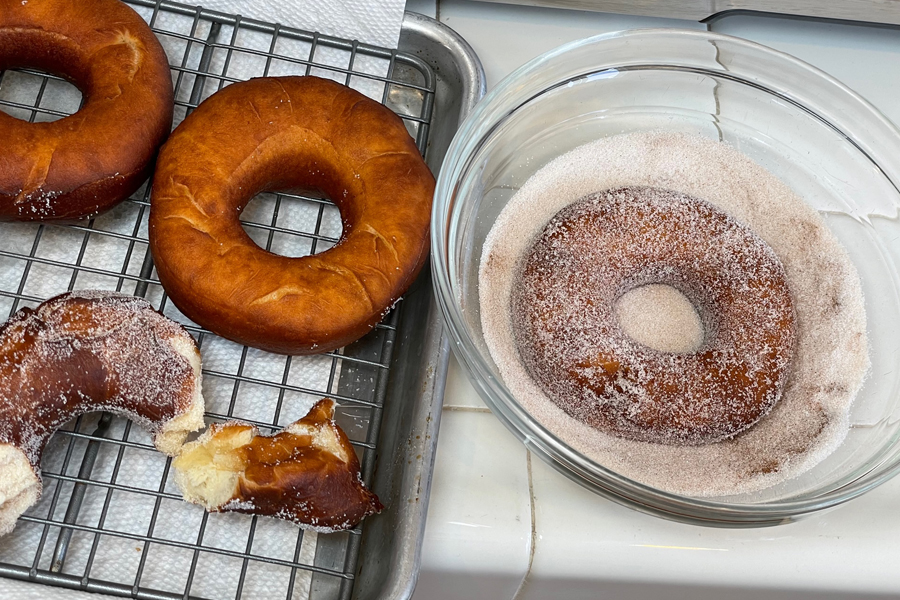 Surprisingly delicious for a first-time effort! The inside was perfectly yeasty with that pillowy soft texture and the outside was delicately fried without being greasy. Even my wife was impressed.
Surprisingly delicious for a first-time effort! The inside was perfectly yeasty with that pillowy soft texture and the outside was delicately fried without being greasy. Even my wife was impressed. 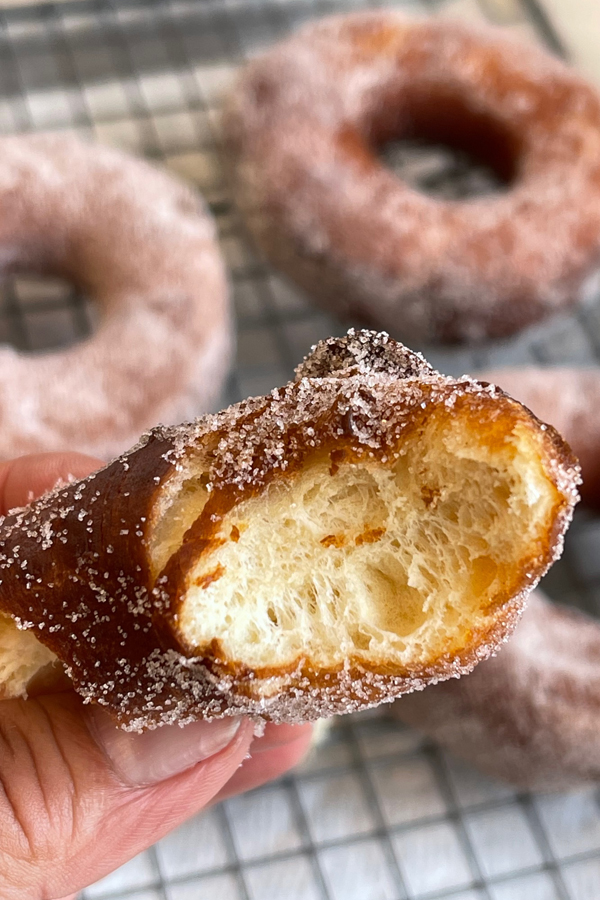 Then I got a little ambitious since I had my breadmaker out anyway, and I still had a big pan of oil. I wanted to try those Mochi Donuts, the ones that look like teething rings? I found a mochi dough recipe and again used my breadmaker to do the work. This one required the dough to rise for 1-1/2 hours, so I used my Zojirushi Micom Toaster Oven and used the RISE function to help.
Then I got a little ambitious since I had my breadmaker out anyway, and I still had a big pan of oil. I wanted to try those Mochi Donuts, the ones that look like teething rings? I found a mochi dough recipe and again used my breadmaker to do the work. This one required the dough to rise for 1-1/2 hours, so I used my Zojirushi Micom Toaster Oven and used the RISE function to help. 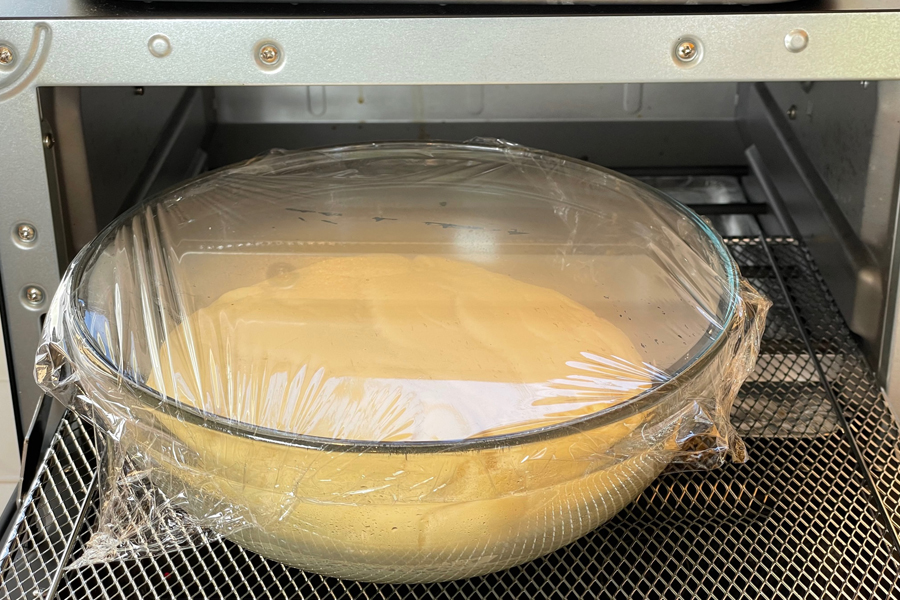 Then it’s a matter of rolling the dough into little balls and sticking them together. Having some oil on your hands helps to manage the dough, while using some water in between the balls helps to stick them together (excuse the low quality of the pic—this is a video capture). You’ll notice they’re resting on squares of parchment paper. This makes it easy to pick them up and drop them into the oil.
Then it’s a matter of rolling the dough into little balls and sticking them together. Having some oil on your hands helps to manage the dough, while using some water in between the balls helps to stick them together (excuse the low quality of the pic—this is a video capture). You’ll notice they’re resting on squares of parchment paper. This makes it easy to pick them up and drop them into the oil. 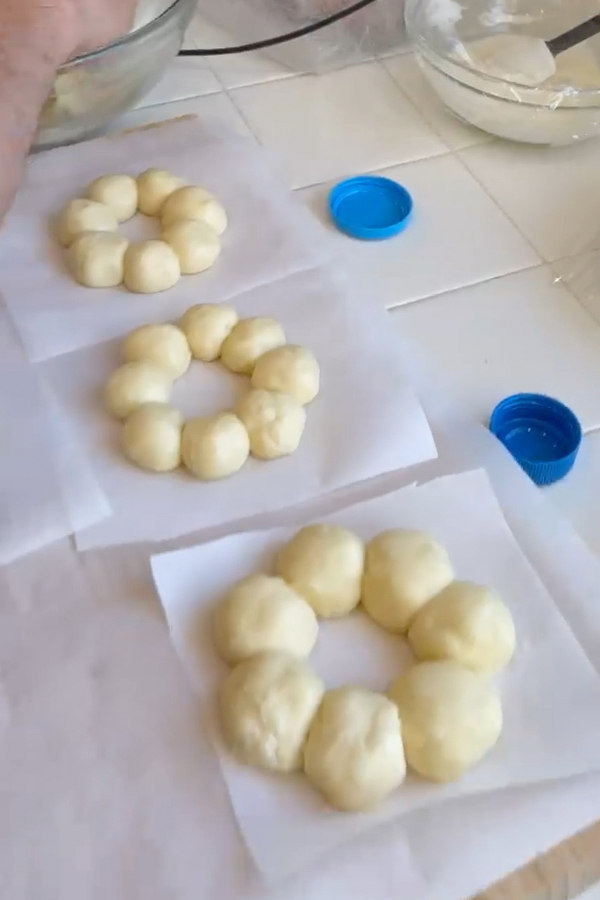 Into the deep fry. The parchment paper easily falls away so you can pick them up with your tongs.
Into the deep fry. The parchment paper easily falls away so you can pick them up with your tongs. 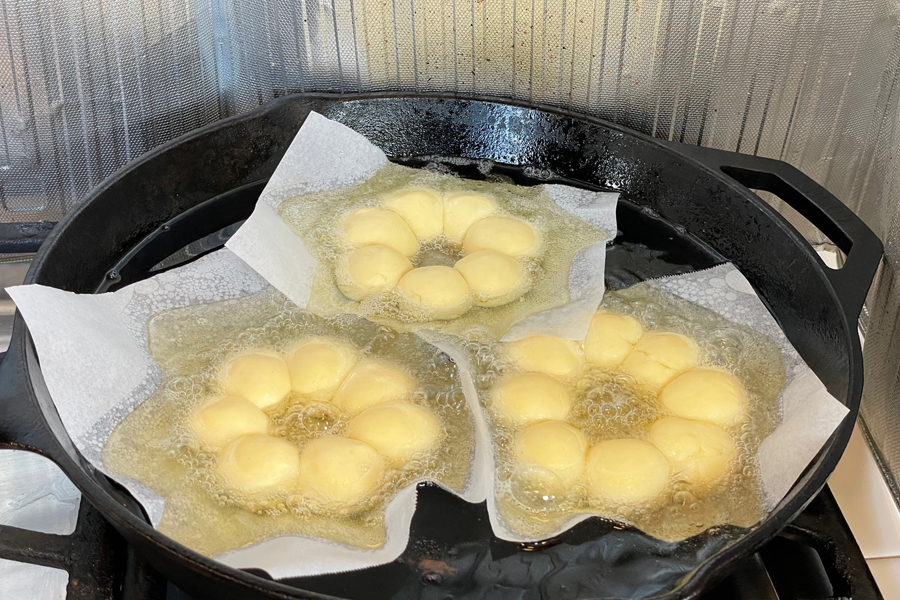 Such a nice golden brown!
Such a nice golden brown! 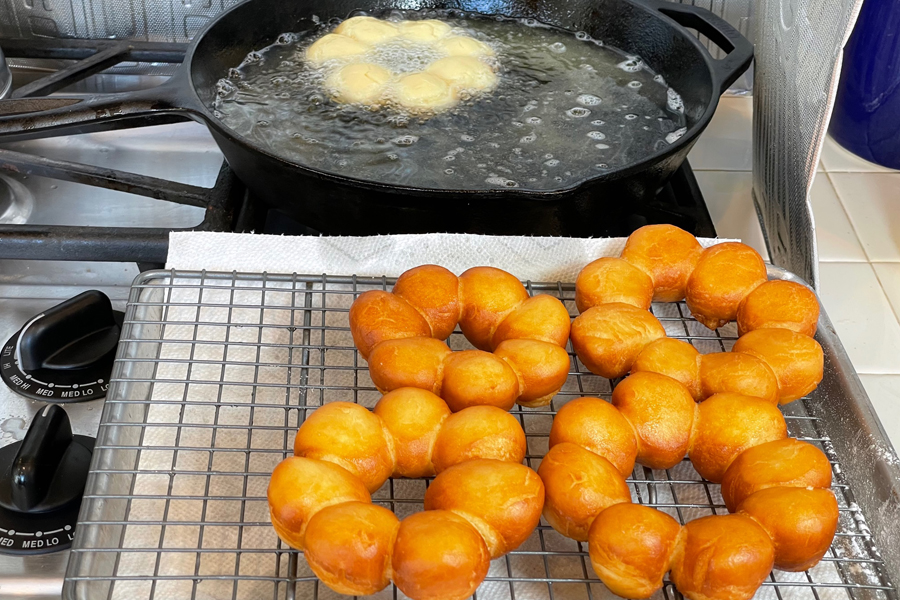 Aaaand Glazed Mochi Donuts—plain and matcha flavors! Not quite like store-bought, but pretty good for homemade.
Aaaand Glazed Mochi Donuts—plain and matcha flavors! Not quite like store-bought, but pretty good for homemade. 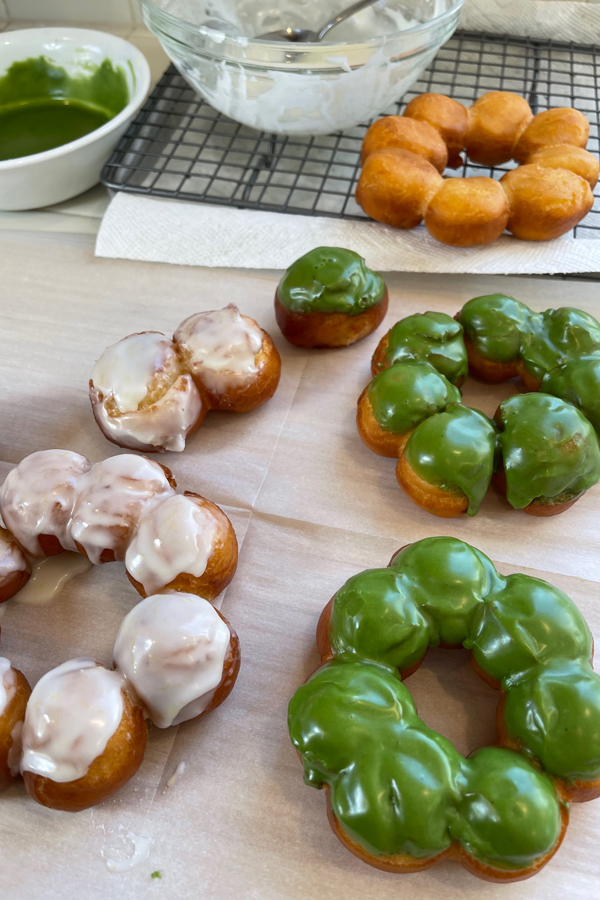 Now you deserve to learn something about donuts in America. This pink box of donuts symbolizes everything about the American dream and about how donuts saved our soldiers during World War I; seriously! See that sticker on this box?
Now you deserve to learn something about donuts in America. This pink box of donuts symbolizes everything about the American dream and about how donuts saved our soldiers during World War I; seriously! See that sticker on this box? 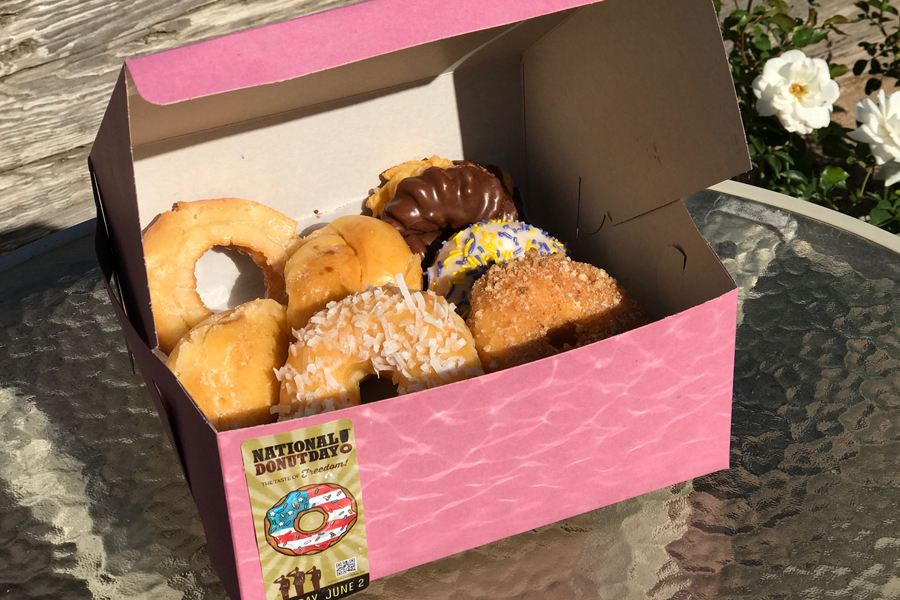 During the war morale was so low among our troops, fighting the war in the trenches in France, that the Salvation Army decided to do something about it. Women volunteers scrounged what ingredients they could and cooked donuts for the men, serving them up near the frontlines. It was hugely popular and gave our soldiers a taste of home cooking. National Donut Day was in fact started by the Salvation Army in 1938, as a way to honor those early “doughnut lassies”, who supported our troops during the war. So there, you can have your donut and feel patriotic about it too! And the pink box? Back in the 1970s, when Cambodian refugees came to Southern California to start new lives in a country totally foreign to them, many of them gravitated to running donut shops. The pink cardboard was cheaper than the white stock used by printers, so these early entrepreneurs started buying pink boxes to save costs rather than skimp on the ingredients. Today it’s estimated that over 80% of the independent donut shops in SoCal are still run by Cambodian American families, a generation removed from the original pioneers who came to find the American dream. I recommend seeing “The Donut King” documentary, about Ted Ngoy, an amazing American success story. So there you have it—you can eat your donut and feel good about it. Have a delicious National Donut Day! Products used in this post: Home Bakery Maestro® Breadmaker BB-SSC10, Micom Toaster Oven ET-ZLC30 Recipes by Art and The Kitchen and Cherree Please note that these recipes were not tested by Zojirushi America. All images by Bert Tanimoto ©2022
During the war morale was so low among our troops, fighting the war in the trenches in France, that the Salvation Army decided to do something about it. Women volunteers scrounged what ingredients they could and cooked donuts for the men, serving them up near the frontlines. It was hugely popular and gave our soldiers a taste of home cooking. National Donut Day was in fact started by the Salvation Army in 1938, as a way to honor those early “doughnut lassies”, who supported our troops during the war. So there, you can have your donut and feel patriotic about it too! And the pink box? Back in the 1970s, when Cambodian refugees came to Southern California to start new lives in a country totally foreign to them, many of them gravitated to running donut shops. The pink cardboard was cheaper than the white stock used by printers, so these early entrepreneurs started buying pink boxes to save costs rather than skimp on the ingredients. Today it’s estimated that over 80% of the independent donut shops in SoCal are still run by Cambodian American families, a generation removed from the original pioneers who came to find the American dream. I recommend seeing “The Donut King” documentary, about Ted Ngoy, an amazing American success story. So there you have it—you can eat your donut and feel good about it. Have a delicious National Donut Day! Products used in this post: Home Bakery Maestro® Breadmaker BB-SSC10, Micom Toaster Oven ET-ZLC30 Recipes by Art and The Kitchen and Cherree Please note that these recipes were not tested by Zojirushi America. All images by Bert Tanimoto ©2022 Since I’ve already confessed to having a weakness for donuts, I won’t feel guilty about celebrating National Donut Day. Nor will I feel guilty about deep frying, since baked donuts just sound lame to me. My excuse is that I’ve never deep fried before so this will be a new experience for me—and in the interest of expanding myself…
Since I’ve already confessed to having a weakness for donuts, I won’t feel guilty about celebrating National Donut Day. Nor will I feel guilty about deep frying, since baked donuts just sound lame to me. My excuse is that I’ve never deep fried before so this will be a new experience for me—and in the interest of expanding myself…
I started by making the dough in my Zojirushi Breadmaker and used a bread machine recipe I found online. That was the easy part—the tricky task was to find a good, decently sized round cookie cutter. You can find all kinds of fancy ones, but try to find basic shapes and it’s not like they’re sold everywhere without having to go online. I know they probably have specialized donut cutters, but I found something that worked. I used this round one and pressed out the hole with a condiment cup I had lying around (I was a dedicated to bringing my lunch from home when I used to commute to work).
 Whoa, this was a little scary for me—I don’t have a tolerance for hot oil. But they look good!
Whoa, this was a little scary for me—I don’t have a tolerance for hot oil. But they look good!
The other scary thing is that you have to work fast because they fry up so quick. As a novice fryer, I was trying to be too delicate with the tongs because I was afraid of ruining the donut. But I got used to just grabbing them with no major accidents.
 All that was left was to dip them in cinnamon sugar for the finishing touch.
All that was left was to dip them in cinnamon sugar for the finishing touch.
Surprisingly delicious for a first-time effort! The inside was perfectly yeasty with that pillowy soft texture and the outside was delicately fried without being greasy. Even my wife was impressed.
 Then I got a little ambitious since I had my breadmaker out anyway, and I still had a big pan of oil. I wanted to try those Mochi Donuts, the ones that look like teething rings? I found a mochi dough recipe and again used my breadmaker to do the work. This one required the dough to rise for 1-1/2 hours, so I used my Zojirushi Micom Toaster Oven and used the RISE function to help.
Then I got a little ambitious since I had my breadmaker out anyway, and I still had a big pan of oil. I wanted to try those Mochi Donuts, the ones that look like teething rings? I found a mochi dough recipe and again used my breadmaker to do the work. This one required the dough to rise for 1-1/2 hours, so I used my Zojirushi Micom Toaster Oven and used the RISE function to help.
Then it’s a matter of rolling the dough into little balls and sticking them together. Having some oil on your hands helps to manage the dough, while using some water in between the balls helps to stick them together (excuse the low quality of the pic—this is a video capture). You’ll notice they’re resting on squares of parchment paper. This makes it easy to pick them up and drop them into the oil.
 Into the deep fry. The parchment paper easily falls away so you can pick them up with your tongs.
Into the deep fry. The parchment paper easily falls away so you can pick them up with your tongs.
Such a nice golden brown!
 Aaaand Glazed Mochi Donuts—plain and matcha flavors! Not quite like store-bought, but pretty good for homemade.
Aaaand Glazed Mochi Donuts—plain and matcha flavors! Not quite like store-bought, but pretty good for homemade.
Now you deserve to learn something about donuts in America. This pink box of donuts symbolizes everything about the American dream and about how donuts saved our soldiers during World War I; seriously! See that sticker on this box?
During the war morale was so low among our troops, fighting the war in the trenches in France, that the Salvation Army decided to do something about it. Women volunteers scrounged what ingredients they could and cooked donuts for the men, serving them up near the frontlines. It was hugely popular and gave our soldiers a taste of home cooking. National Donut Day was in fact started by the Salvation Army in 1938, as a way to honor those early “doughnut lassies”, who supported our troops during the war. So there, you can have your donut and feel patriotic about it too!
And the pink box? Back in the 1970s, when Cambodian refugees came to Southern California to start new lives in a country totally foreign to them, many of them gravitated to running donut shops. The pink cardboard was cheaper than the white stock used by printers, so these early entrepreneurs started buying pink boxes to save costs rather than skimp on the ingredients. Today it’s estimated that over 80% of the independent donut shops in SoCal are still run by Cambodian American families, a generation removed from the original pioneers who came to find the American dream. I recommend seeing “The Donut King” documentary, about Ted Ngoy, an amazing American success story.
So there you have it—you can eat your donut and feel good about it. Have a delicious National Donut Day!
Products used in this post: Home Bakery Maestro® Breadmaker BB-SSC10, Micom Toaster Oven ET-ZLC30
Recipes by Art and The Kitchen and Cherree
Please note that these recipes were not tested by Zojirushi America.
All images by Bert Tanimoto ©2022
Everything You Need to Know about Rice Flour
Rice is by far one of the most versatile foods on the planet, feeding over half of the world every day. But did you know that when it’s ground into a fine powder, rice is a gluten-free, silky smooth, and nutrient-rich flour alternative for home bakers? It’s easy to make, easy to use, and easy to incorporate into your favorite Zojirushi breadmaker recipes. Let us show you why.
What is Rice Flour?
Simply put, rice flour is a fine flour made by grinding rice grains of all types. You can buy pre-ground rice flour at the store but grinding rice flour at home gives you more room to experiment with different rice varieties and to find the taste and texture you love most.
Different types of rice flour include:
- Glutinous rice flour
- Brown rice flour
- Black rice flour
- White rice flour
- Wet-milled rice flour: You can also differentiate your rice flour by determining how it was milled. Rice flour can be made from dry rice grains, or alternatively, wet rice grains that were soaked in water prior to milling. Wet-milled rice is a traditional Korean milling technique and a more expensive process for making rice flour which is almost always stored frozen. Some people prefer wet-milled rice flour for making moist foods, like Korean tteok or Korean rice cakes.
You can easily make rice flour at home in a grain mill, blender, coffee grinder, or even food processor. If you plan on making your own rice flour, make sure to start with small amounts so that the rice can blend into a finer powder consistency. Adding too much rice at once can result in large chunks or an uneven consistency. The finer your rice flour, the better it will be for baking.
Brown rice vs. white rice: Different types of rice will result in different flavors, which adds to the beauty of baking with rice flours. White rice tends to be the most neutral tasting, but brown rice flour will have a more earthy taste. Brown rice also has a higher source of fiber, so it can be easier to digest.
After you’ve made your homemade rice flour, make sure to label and date it and store in in the fridge or freezer for up to a year.
What are the benefits of Rice Flour?
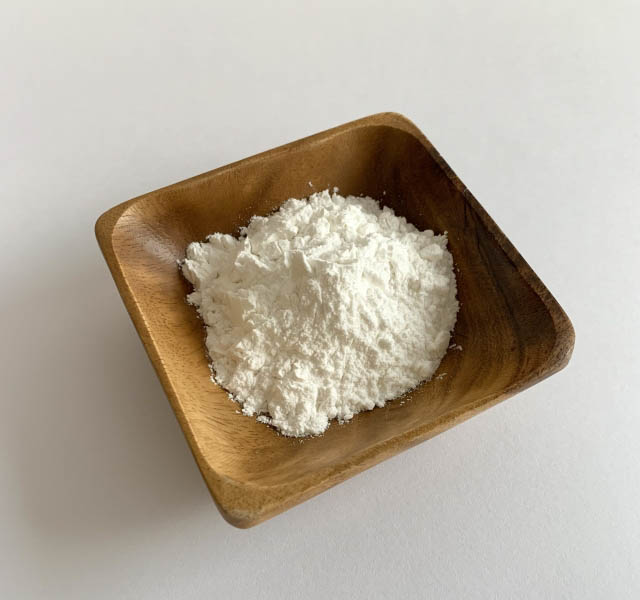
You might be wondering, is rice flour healthy? The short answer is yes! Rice flour made from white or brown rice is naturally gluten-free and a great alternative for anyone with celiac disease or gluten sensitivities. It’s also low in sodium, cholesterol, and saturated fat, and because it is enriched with vitamins and minerals, it gives you more nutritional bang for your buck. Because rice has high amounts of fiber, it’s easy on the stomach as well. Lastly, rice is also affordable and has a long shelf life, so you don’t have to worry about your rice flour going bad anytime soon.
Our Favorite Zojirushi Rice Flour Recipes
Now that you’ve learned all you need to know about rice flour, are you ready to start baking? Here are some of our top rice flour recipe recommendations that you can make in your Zojirushi breadmaker for a sweet or savory snack the whole family will enjoy.
You can make any of these below recipes using the “gluten free course” on your Zojirushi Breadmaker or using the Home Made feature on the Home Bakery Supreme® Breadmaker BB-CEC20. For our friends with the Home Bakery Mini BB-HAC10, find gluten free recipes in the instruction manual or try the Butter Mochi recipe below.
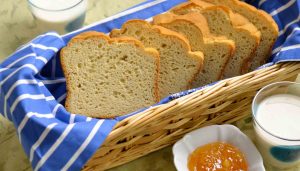 Gluten Free Brown Rice Bread: In this recipe, we mix brown rice flour with eggs to add flavor, protein, and moisture to the bread. Potato starch and xanthan gum are used to replace the gluten. Perfect for sandwiches, toast, or your favorite jams and butters.
Gluten Free Brown Rice Bread: In this recipe, we mix brown rice flour with eggs to add flavor, protein, and moisture to the bread. Potato starch and xanthan gum are used to replace the gluten. Perfect for sandwiches, toast, or your favorite jams and butters.
Butter Mochi: A savory dessert that uses sweet rice flour for a soft and chewy cake. You may see these around Hawaii, where it’s a local gluten-free favorite.
Gluten & Guilt Free Donuts: Fluffy and delicious, you won’t notice the difference with regular donuts. These sweet treats are best enjoyed with a cup of coffee and sharing with friends and family.
For more rice flour or gluten-free bread recipes, visit our breadmaker recipe page on our website.
Do you have any special rice flour recipes or tips to share with us? Let us know on social media by tagging your photos on Twitter, Facebook or Instagram! #Zojirushi #ZoFan
Meet Zojirushi’s Full Breadmaker Lineup: Choosing the Right Breadmaker for You
As you know, at Zojirushi we draw inspiration from daily life. And with that in mind, there are few items as relevant to everyday life as bread and bread products. We launched our very first breadmaker, the Home Bakery Breadmaker, in 1988 (over 30 years ago!) and haven’t looked back since. Today, we offer four different breadmakers, each with a wide range of capabilities that allow them to bake different types of breads and some even make jam, pizza dough, meatloaf, and bake gluten-free bread. With all these different features, we thought that it would be a good idea to introduce you to each breadmaker to help you choose the right machine for you. Are you ready to meet the breadmaker members of our family?
Our four breadmakers are as follows (pictured left to right):
- Home Bakery Mini Breadmaker BB-HAC10
- Home Bakery Maestro® Breadmaker BB-SSC10
- Home Bakery Supreme® Breadmaker BB-CEC20
- Home Bakery Virtuoso® Plus Breadmaker BB-PDC20
The “Supreme” and “Virtuoso” are the bigger capacity breadmakers, while the “Mini” and “Maestro” are the smaller breadmakers. An easy way to distinguish between the breadmakers sizes is by looking at the numbers at the end of each product ID. If it ends in a “10,” it’s smaller. If it ends in a “20,” it’s larger.
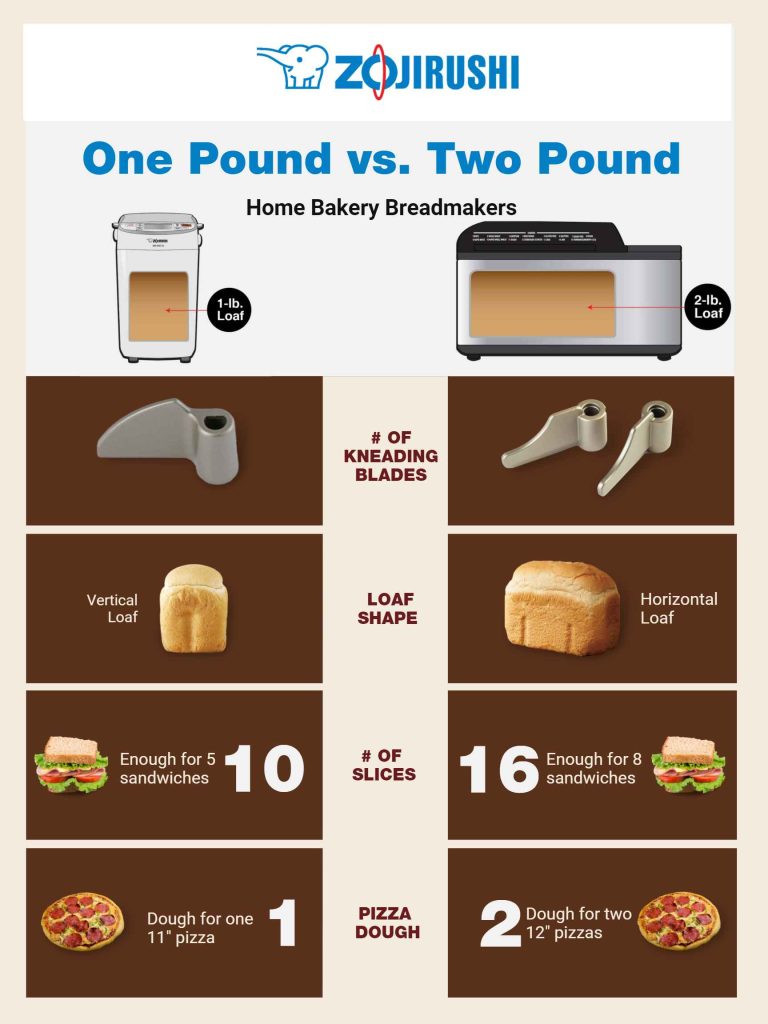 We make a breadmaker that fits every household, each packed with settings for different types of breads to fit your own preferences and dietary needs. There are two different sizes of bremakers that make two types of bread shapes: vertical and horizontal.
We make a breadmaker that fits every household, each packed with settings for different types of breads to fit your own preferences and dietary needs. There are two different sizes of bremakers that make two types of bread shapes: vertical and horizontal.
Models Home Bakery Maestro® Breadmaker BB-SSC10 and Home Bakery Mini Breadmaker BB-HAC10 bake a 1-lb. mini loaf in a vertical shape. This small loaf is large enough to make about 5 sandwiches. If you like baking your own pizza at home, the dough made in the 1-lb. breadmakers is enough to make an 11” pizza.
Models Home Bakery Virtuoso® Plus Breadmaker BB-PDC20 and Home Bakery Supreme® Breadmaker BB-CEC20 bake a 1.5-2lb. loaf in a traditional horizontal shape. When the loaf can yield up to 16 slices of bread and if you’re interested in pizza dough you can make enough for two 12” pizzas.
Zojirushi Breadmaker Features and Specifications
After choosing the best size breadmaker that fits your needs, let’s dive into some of the different functions each breadmaker offers. If you’re looking to make specific types of breads, like multi-grain, vegan, or gluten free make sure to take a close look at the preset courses in this chart:
To learn more about Zojirushi breadmaker Course Settings, visit this link.
All Zojirushi breadmakers include:
- Full color recipe booklet
- Measuring cup
- Measuring spoon
- Instructional video
Closing Thoughts and Tips on How to Make Bread
Though our breadmakers may look different and have different course settings and customization options, it’s essential to follow the same guidelines for all Zojirushi breadmakers to ensure that you bake a perfect loaf every time. Here is a snapshot of the basics about bread you need to know when you start baking!
- Use fresh ingredients and measure accurately
- Attach blade(s) to the baking pan
- Add ingredients in the correct order
- Select the course and hit START! Happy baking!
Now that you’ve met all of our breadmakers, which exciting feature are you looking forward to using for your next baking adventure? Did you learn anything new about bread and how to make bread? Be sure to share your dishes with us on social by tagging your photos on Twitter, Facebook, or Instagram! #Zojirushi #ZoFan
Asian American Month
Let’s celebrate Asian American and Pacific Islander (AAPI) Month…it feels kinda important these days. It’s a good excuse to eat Asian type foods because eating is universal, all-inclusive, joyous and loved by everyone. If you’ve been to this space before, you’ve probably seen me try to cook the local Hawaiian type favorites, but this month I wanted to try a couple of off-beat Asian-American dishes.
Sushi Bake
Have you ever tried this? It seems like an oxymoron, I know…who bakes sushi? But believe me, this was so easy (and you know me, I love easy) and so good. It’s basically built in layers like you see above, with prepared sushi rice, furikake (rice sprinkles) and a mixture of fake crab, green onion, mayo and sriracha for some kick. The orange fish roe (masago) is added for crunchy texture.
You then bake it in your toaster oven for a bit (there are gobs of recipes online if you want to learn more) and it’s pretty much done. The point to baking this seems to neutralize the richness of the mayo mixture so that it not only warms it, it makes it more palatable and easier to eat. You could eat this cold, but I have a feeling you’d get tired of it in a few bites.
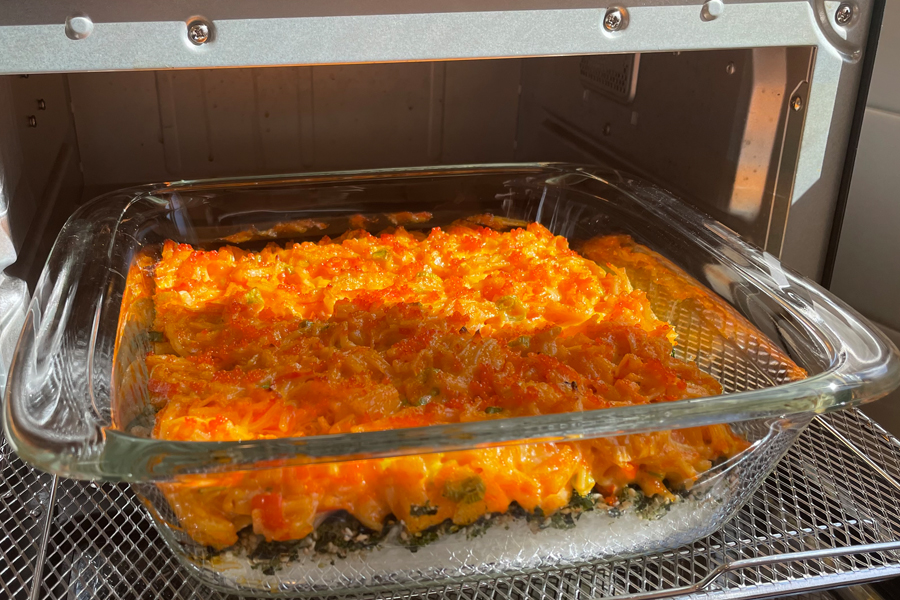
Then I added chunks of avocado and cucumber as a topping before serving. It’s basically a deconstructed California Roll in a casserole.
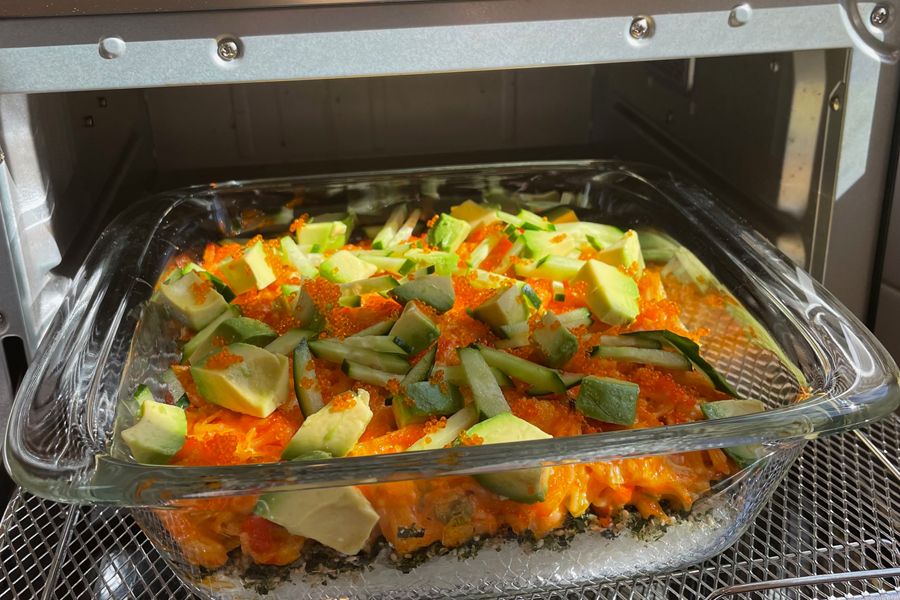
To eat this, all you do is get some nori (seaweed) sheets and roll your own. It makes a great communal dish to serve on your dining table. Try it—it’s pretty habit forming.
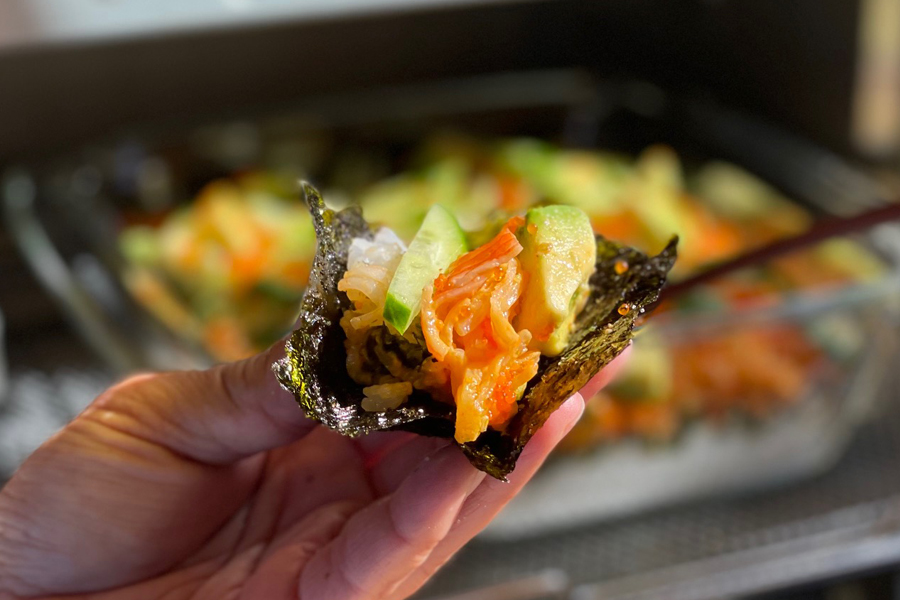
While I was thinking about AAPI Month, I remembered a story that my mother told me about our family during WWII. No, I’m not that old, but my parents’ generation goes back that far and a lot of Japanese-American history goes back that far. It seems my Aunt (mother’s side) was in Japan when the war broke out. The family lost all contact and did not know her whereabouts until the war ended. During the official surrender ceremonies, my Uncle (my aunt’s brother) who was a Japanese language expert for the U.S. military, met by sheer chance, the English expert for the Japanese Imperial Army. He was also a Japanese-American who served the Japanese when the war started.
It’s important to understand how Japanese-Amercans were living and working on both sides of the Pacific Ocean back then, and how the great War forced everyone to prove their loyalties just to survive. The two men introduced themselves and upon learning the American interpreter’s name, the Japanese officer found out that his wife in Japan and this man had the same last name, and that he was actually married to his sister. They were brothers-in-law who had never met before, and here they saw each other for the first time during Japan’s surrender to America to end World War II. The men shook hands, my Japanese uncle simply said to my American uncle, “Look me up in Japan,” and he drove off. This encounter was briefly mentioned in John Toland’s Pulitzer Prize winning book, The Rising Sun, and I’ve always found it a fascinating part of not only our family, but of Japanese-American history in general.
OK, history class dismissed—back to the tasty stuff.
Curry Chicken
I really don’t know where this recipe originates, but it’s good with rice! And it’s easy (there’s that word again).
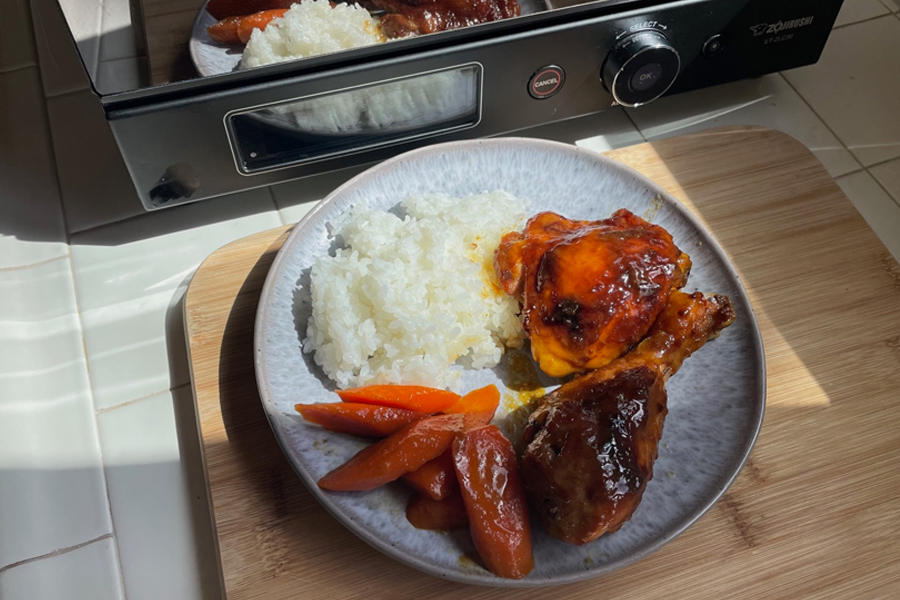
Here’s the recipe I used in case you want to try:
CURRY MUSTARD CHICKEN
1/2 cup warmed honey
1/2 cup Dijon mustard
1/4 cup soy sauce
2 tsp curry powder
2 cloves minced garlic
Chicken legs and thighs
Mix first five ingredients and pour over chicken pieces. Bake at 375°F for 1 hour. Baste occasionally to prevent chicken drying out.
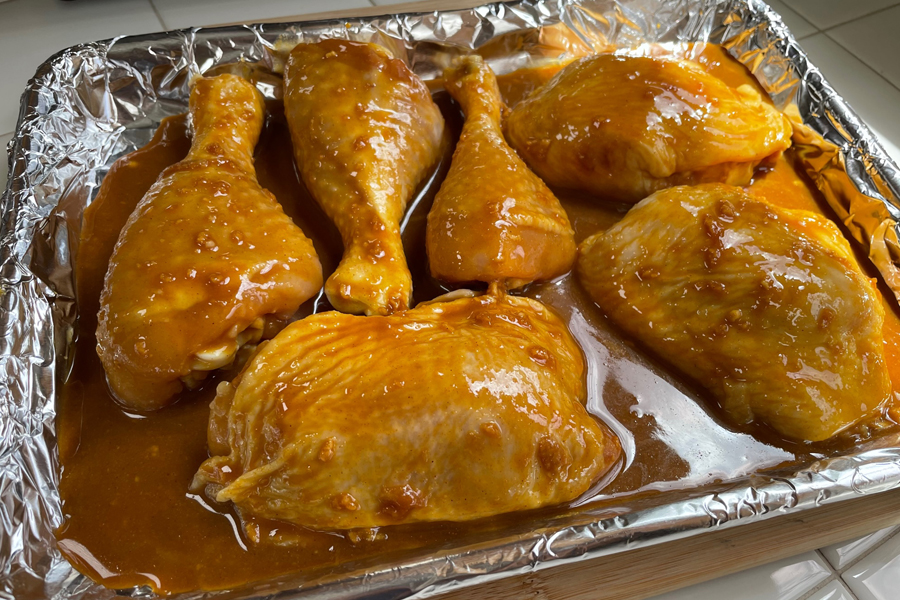
I suggest using a disposable pan or lining yours with foil because this gets sticky.
Baste occasionally to prevent chicken drying out.
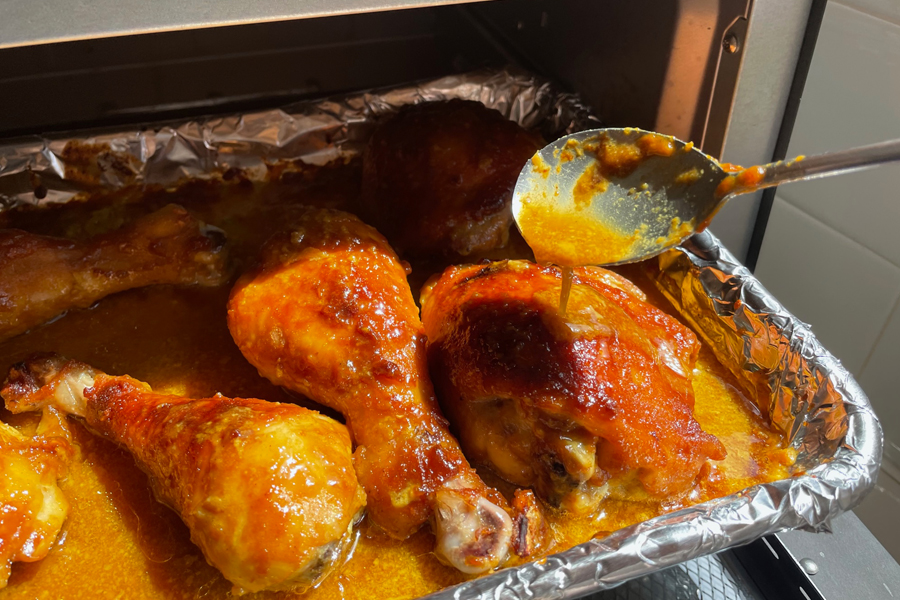
Not bad, huh? I was actually thinking of doing Shoyu Chicken for Asian American Month, but this was a much more interesting alternative.
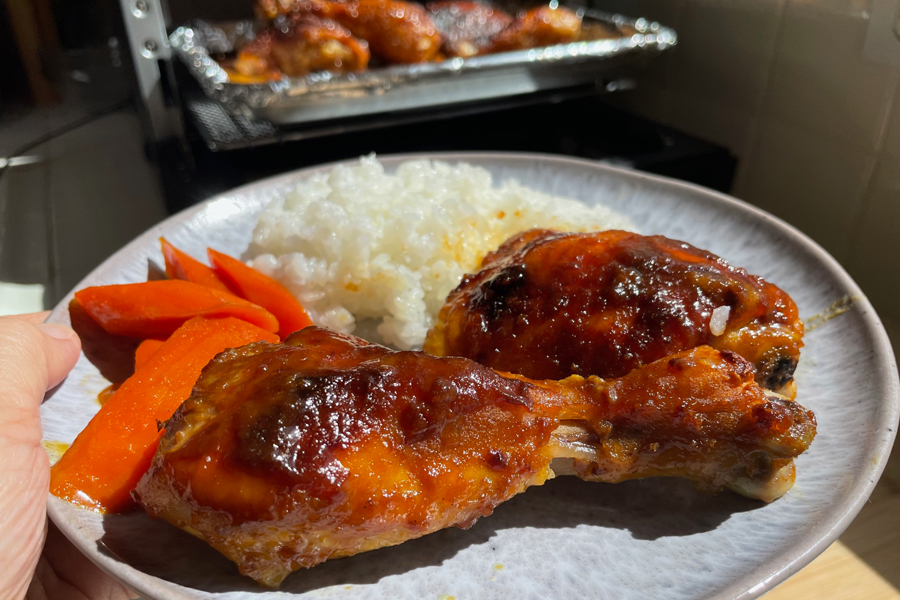
Earlier this year I did some typical Hawaiian local favorites, so if you’re interested you can check them out here, and celebrate Asian American Month some more!
source: Toland, John. The Rising Sun, The Decline and Fall of the Japanese Empire 1936-1945, Random House 1970
Products used in this post: Micom Toaster Oven ET-ZLC30
Please note that these recipes were not tested by Zojirushi America.
Pressure Induction Heating Rice Cooker & Warmer NW-JEC10/18
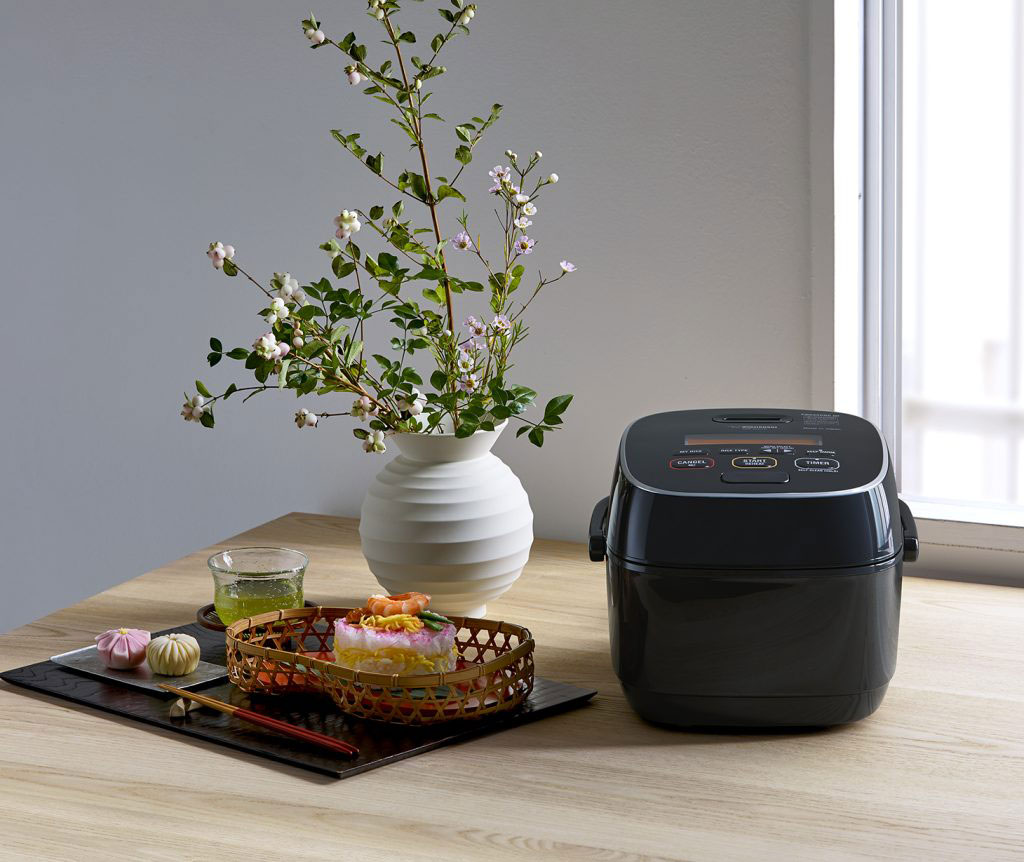 Are you ready to meet the newest member of our Zojirushi lineup? Our highest quality pressure IH rice cooker to date is here – the Pressure Induction Heating Rice Cooker & Warmer NW-JEC10/18. With up to 49 different customization settings, superior induction heating (IH) technology, our signature fuzzy logic smart rice cooking technology, and all made in Japan, this rice cooker truly cooks your rice your way. There are many more special features that we are excited to show you on this Zojirushi rice cooker, so let’s get to it!
Are you ready to meet the newest member of our Zojirushi lineup? Our highest quality pressure IH rice cooker to date is here – the Pressure Induction Heating Rice Cooker & Warmer NW-JEC10/18. With up to 49 different customization settings, superior induction heating (IH) technology, our signature fuzzy logic smart rice cooking technology, and all made in Japan, this rice cooker truly cooks your rice your way. There are many more special features that we are excited to show you on this Zojirushi rice cooker, so let’s get to it!
A Quick Look
The Zojirushi Pressure Induction Heating Rice Cooker & Warmer comes in a sleek “Silky Black” color with a large easy-to-read, orange LCD control panel located right on top. Available in two sizes, 5.5 cups or 10 cups, this versatile rice cooker also features a detachable inner lid with an integrated steam vent that makes the cleaning process simple and hassle-free.
As always, all surfaces that come into contact with food are BPA-free, and the iron coated and platinum infused nonstick inner cooking pan changes the water quality for sweeter-tasting rice and provides even heating.
Don’t forget the accessories! Cook your rice perfectly every time with the dedicated rice measuring cup that comes with the rice cooker and fluff your rice with joy with the included self-standing spatula.
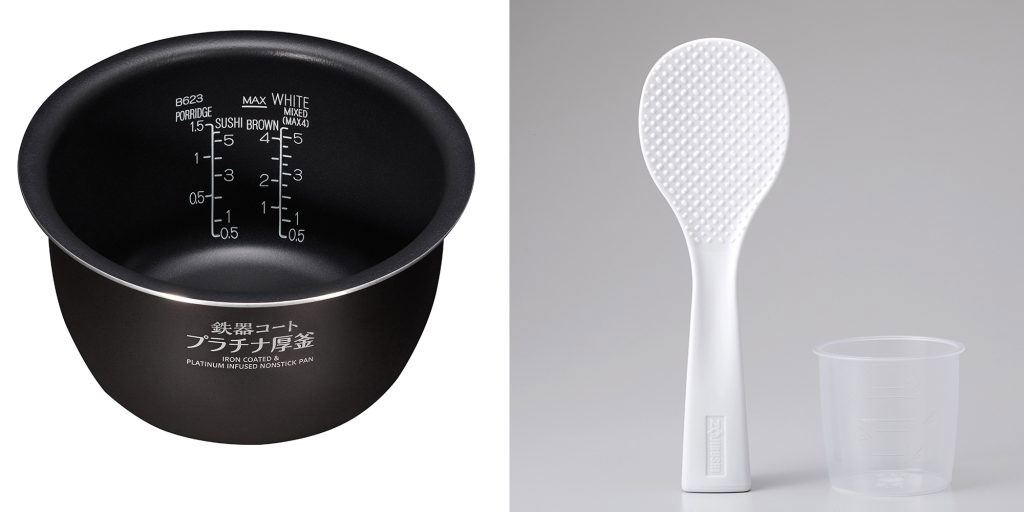
Iron coated and platinum infused nonstick coated inner pan, self-standing spatula, and rice measuring cup.
The Technology
We know that this is a pretty-looking appliance on the outside, but it’s really what’s on the inside that counts. Here’s a look at the technology that truly makes this rice cooker stand apart from the rest:
- Pressurized Cooking: The simultaneous pressurized cooking and steaming infuses the sweetness back to each grain during the cooking process and produces sticky and plump rice. No need to worry about dry or overcooked rice – ever. The multiple fail-safe measures guarantee safe pressure cooking. And the sensors make sure that all parts are set up properly before starting to cook.
- New Premium Convection: Combining high heat with high pressure creates strong convection that stirs the rice while it cooks, enhancing the sweetness and delicious flavor of the rice.
- Artificial Intelligence: We designed this Zojirushi rice cooker with our signature advanced fuzzy logic technology with AI, which intelligently adjusts the cooking cycle to cook rice to perfection regardless of season or ambient temperature. There is also a self-cleaning function that keeps the rice cooker clean and prevents any unpleasant odors from lingering over time, keeping this rice cooker good as new for years.
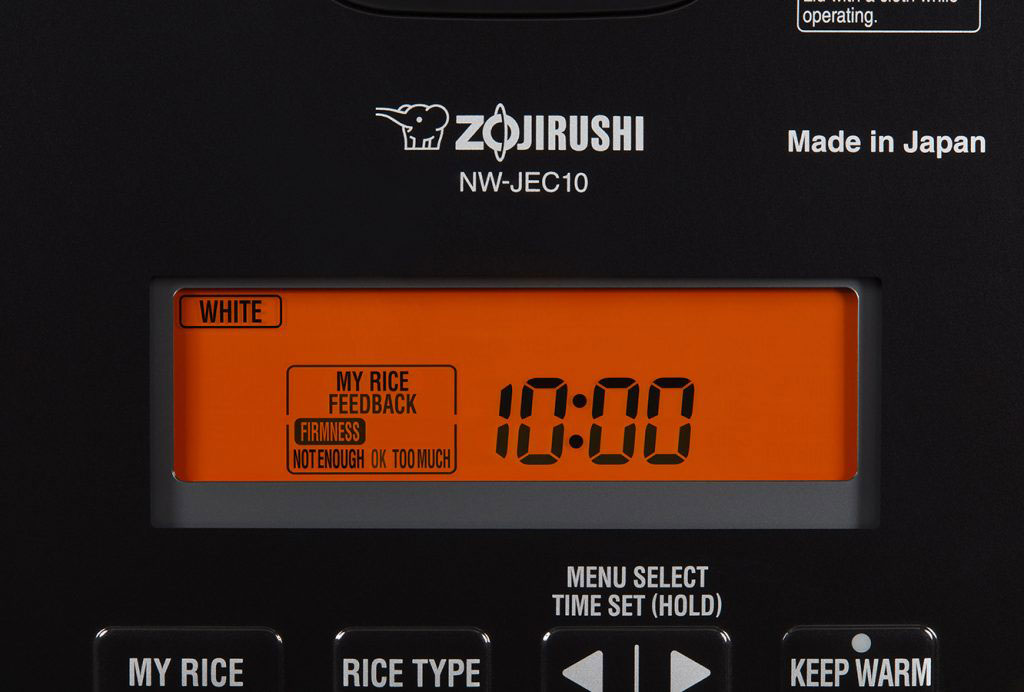
Just input how the rice turned out (firmness and stickiness), the rice cooker will make small changes to the cooking flow until it gets to the way you like it
- Multi-menu Cooking Functions: This appliance comes packed with settings that allow you to cook different types of rice. The new “My Rice (49 Ways)” menu setting makes small changes to the cooking cycle based on your feedback on the firmness and stickiness of white rice. But that’s not all! This appliance includes umami, mixed, sushi, Jasmine, porridge, congee, brown, GABA brown, steel cut oatmeal, quick white, and quick Jasmine menu settings.
To see this rice cooker in action, make sure to watch the product video for more info. You can find plenty of rice recipes on our website as well, on zojirushi.com.
What is your favorite feature on the new Pressure Induction Heating Rice Cooker & Warmer NW-JEC10/18? Be sure to share your thoughts with us on social by tagging your photos on Twitter, Facebook or Instagram! #Zojirushi #ZoFan
